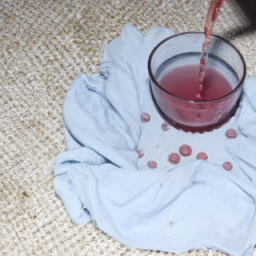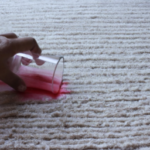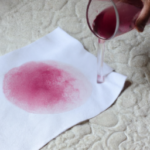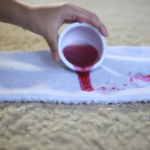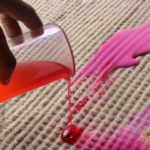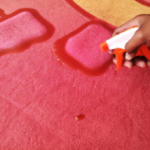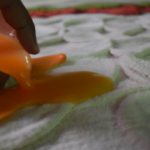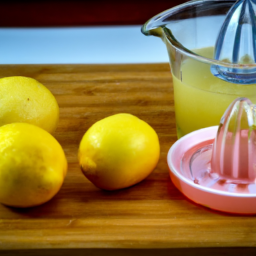Oh, the delight of a new mark on my rug. This time, it’s grape juice – a top pick of mine! I’ve learned a thing or two about managing spills, and I’ve realized that whining about spilled juice won’t help. It’s better to quickly and skillfully clean it up. If you want to avoid carpet stains, keep reading!
In this article, I’ll be sharing my tried and true method for getting grape juice out of the carpet.
First things first, don’t panic! The key to removing grape juice (or any stain for that matter) is to act quickly. The longer the juice sits, the deeper it will penetrate the fibers of the carpet, making it harder to remove.
So, take a deep breath and let’s get started. With my step-by-step guide, you’ll be able to tackle that pesky grape juice stain in no time.
Key Takeaways
- Act quickly and blot the excess juice with a clean cloth
- Use a specialized carpet cleaner or create a cleaning solution with water and dish soap
- For tougher stains, add white vinegar and baking soda to the mix
- Use spill-proof cups to prevent future spills
Act Quickly
Don’t wait, you’ve gotta act fast if you want to get that grape juice out of your carpet! Reacting quickly is the key to preventing the stain from setting in.
As soon as you notice the spill, grab a clean cloth and blot the excess juice gently. Avoid rubbing or scrubbing as that can push the stain deeper into the carpet fibers.
Once you’ve blotted up as much of the juice as possible, it’s time to use a specialized carpet cleaner. Look for a product that’s designed to tackle tough stains like grape juice. Follow the manufacturer’s instructions carefully and apply the cleaner to the affected area.
Leave it on for the recommended amount of time and then blot it up with a clean cloth. Now, let’s move on to the next step – blotting the excess juice.
Blot the Excess Juice
First, you need to quickly grab a clean cloth and start pressing it onto the stained area to absorb as much of the liquid as possible. Don’t rub the cloth on the carpet as it may push the grape juice deeper into the fibers. Instead, gently blot the excess juice using an up and down motion. Repeat this process until there is no more liquid coming out of the carpet.
Once you’ve removed as much grape juice as possible, the next step is to use a carpet cleaner to treat the remaining stain. Make sure to follow the manufacturer’s instructions and test the product on a small, inconspicuous area first to avoid any damage to the carpet. After the stain has been treated, it’s important to prevent future spills by keeping drinks away from the carpeted area or using spill-proof cups.
Moving on to the next section, the first step in creating a cleaning solution is to combine white vinegar and water.
Create a Cleaning Solution
So, to create a cleaning solution for getting grape juice out of your carpet, I typically mix water and dish soap together in a spray bottle. This helps to break down the stain and lift it out of the fibers.
For tougher stains, I also add a bit of white vinegar and baking soda to the mix. The vinegar helps to neutralize odors and the baking soda acts as a natural abrasive to help scrub away the stain.
With this powerful combination, I’ve been able to successfully remove even the toughest grape juice stains from my carpets.
Mix water and dish soap
To tackle the grape juice stain on your carpet, simply mix some water and dish soap together. This solution is effective for a variety of stains and has many benefits. Here are three reasons why:
-
Dish soap is designed to break down and remove grease and oil. This makes it a great choice for tackling tough stains like grape juice.
-
Water is a natural solvent that helps to dilute and lift stains from the fibers of your carpet.
-
Using this solution is a cost-effective and easy way to remove stains without having to purchase expensive cleaning products.
When mixing the water and dish soap, be sure to use a gentle touch and not saturate the carpet. Use a clean cloth to blot the stain and work from the outside in to prevent spreading the stain further.
Once you’ve removed as much of the grape juice as possible, move on to the next step: using white vinegar and baking soda.
Use white vinegar and baking soda
Now, let’s see how you can easily remove that stubborn grape juice stain using white vinegar and baking soda. These alternative methods are effective and safe for your carpet. However, it’s important to take some precautionary measures to avoid damaging your carpet.
First, mix one tablespoon of white vinegar with one tablespoon of baking soda in a small bowl until it forms a paste. Then, apply the paste onto the stain and let it sit for 5-10 minutes.
After that, use a damp cloth to gently rub the stain until it disappears. Finally, rinse the area with water and dry it with a towel.
To ensure that this method won’t cause any damage to your carpet, it’s always recommended to test the solution on a small, inconspicuous area first. This will help you determine if the solution is safe to use on your carpet and prevent any further damage.
Once you’ve tested the solution, you can confidently proceed to remove that stubborn grape juice stain with the white vinegar and baking soda paste.
Test the Solution
You’ll want to make sure that the grape juice stain is completely gone before moving on to applying the white vinegar and baking soda solution. To do this, I recommend testing the effectiveness of the solution on a small, inconspicuous area of the carpet first.
This will ensure that the solution won’t cause any damage or discoloration to your carpet, and that it will effectively remove the stain. Testing the solution is especially important if you’re working with time constraints.
You don’t want to waste time applying the solution to the entire stain, only to find out that it’s not effective or that it causes more damage to your carpet. By testing the solution first, you’ll be able to determine if it’s the right solution for your particular stain, and you’ll be able to move on to applying the solution with confidence.
Apply the Solution
When I applied the solution to my grape juice stain, I made sure to use a clean cloth or sponge. This helped to avoid any additional dirt or debris from getting onto the carpet.
I then gently blotted the stain, being careful not to rub it in further. This method proved effective in removing the stain without causing any damage to the carpet fibers.
Use a clean cloth or sponge
Using a soft cloth or sponge soaked in warm water, gently blot the grape juice stain to lift as much of the liquid as possible. It’s important to use a clean cloth or sponge to avoid spreading the stain further.
Here are some tips to help you effectively lift the stain:
- Start from the outside of the stain, working your way towards the center to prevent spreading the grape juice.
- Use a dabbing motion instead of rubbing to avoid damaging the carpet fibers.
By using these techniques, you can effectively lift the grape juice stain from your carpet without causing further damage. Once you’ve lifted as much of the stain as possible, move on to the next step of treating the stain.
Blot the stain gently
Gently dab at the stain with a clean cloth or sponge, as though you’re trying to coax a delicate flower to bloom. Blotting techniques are essential when it comes to effectively removing grape juice stains from carpets. Use a gentle, up-and-down motion to absorb as much of the stain as possible.
Avoid rubbing the stain, as this can cause it to spread and embed deeper into the fibers of the carpet. Continue blotting the stain until no more grape juice is transferring onto the cloth or sponge.
Effective stain removal requires patience and attention to detail. If the stain is particularly stubborn, try using a mixture of white vinegar and baking soda. Apply the mixture to the stain, let it sit for a few minutes, then blot it up with a clean cloth.
Once you’ve removed as much of the stain as possible, rinse the area with cold water and blot it dry. With these simple techniques, you can effectively remove grape juice stains from your carpet and restore its pristine appearance.
Rinse the Area
To rinse the area, simply blot the stain with a damp cloth. It’s important to use a clean cloth, as using a dirty one can cause the stain to spread. If the stain is particularly stubborn, you can use a mixture of water and vinegar to help break it down.
To prevent future spills, it’s always a good idea to use a spill-proof cup or bottle when drinking grape juice. Additionally, make sure to clean up any spills immediately to prevent them from setting in. By taking these simple steps, you can keep your carpet looking clean and fresh. If the stain persists, repeat the process until it’s completely removed.
Repeat if Necessary
If the grape juice stain remains on the carpet, I recommend repeating the cleaning process.
It’s important to be patient and persistent in removing the stain.
Don’t give up if the first attempt doesn’t work, as it may take several tries to completely remove the stain.
If the stain remains, repeat the process
Don’t worry if the stain is still there, just repeat the process and keep your fingers crossed for better luck this time! Sometimes, grape juice stains can be stubborn and require a few attempts to fully remove.
Here are a few prevention tips and different types of grape juice stains to keep in mind as you tackle the stain:
-
Prevention tips: Consider using a spill-proof cup or placing a towel or mat under your drink to catch any spills. Also, be sure to act quickly if a spill does occur to prevent the stain from setting in.
-
Red grape juice stains: These stains tend to be more difficult to remove than white grape juice stains. If the stain remains after the first attempt, try using a mixture of dish soap and white vinegar to break down the stain.
-
White grape juice stains: While these stains may be easier to remove, they can still leave a mark if not treated promptly. If the stain remains, try using a solution of baking soda and water to lift the stain.
-
Set-in stains: If the stain has been there for a while, it may require more aggressive tactics such as using a carpet cleaner or hiring a professional cleaner.
Be patient and persistent as you work on removing the grape juice stain. With a little effort and some trial and error, you can successfully remove the stain and restore your carpet to its original state. If the stain remains, repeat the process.
Be patient and persistent
Just be patient and keep at it, you’ll have that stubborn grape juice stain out of your carpet in no time! Removing a grape juice stain from your carpet can be frustrating, but with practice patience and persistence, you can successfully remove the stain. Here are some tips for removing grape juice stains from carpet:
| Tip 1 | Blot the stain immediately with a clean cloth, do not rub |
|---|---|
| Tip 2 | Apply a mixture of white vinegar and water to the stain and let it sit for 10-15 minutes |
| Tip 3 | Blot the stain with a clean cloth until the stain lifts |
It’s important to avoid spreading the stain while cleaning it. Proper techniques for cleaning grape juice spills on carpet include blotting the stain immediately with a clean cloth and not rubbing the stain. Remember to be patient and persistent with removing the stain. Once the stain is removed, the next step is to dry the area thoroughly.
Dry the Area
So, now that the grape juice’s been successfully removed from the carpet, it’s important to make sure the area’s completely dry.
To do this, I recommend using a clean towel or paper towel to absorb as much moisture as possible. It’s also important to avoid walking on the area until it’s completely dry to prevent any additional damage or staining.
By taking these steps, you can ensure that your carpet’s back to its original state and ready for use once again.
Use a clean towel or paper towel
To remove grape juice from your carpet, grab a clean towel or paper towel and gently blot the stain until it’s as dry as the Sahara Desert. Did you know that the Sahara Desert is the largest hot desert in the world, covering an area of about 3.6 million square miles? Anyway, back to the grape juice stain. It’s important to use a clean towel or paper towel to avoid spreading the stain further. If the stain is still wet, try to absorb as much of the juice as possible by pressing down on the affected area with the towel.
Once you’ve blotted the stain and it’s as dry as the Sahara Desert, you can move on to the next step. But before we do that, let’s take a look at some alternative cleaning solutions for grape juice stains on carpet. In case you don’t have vinegar on hand, you can try using club soda or a mixture of dish soap and hydrogen peroxide. These solutions are effective in breaking down the stain and lifting it off the carpet fibers. Just remember to test them on a small, inconspicuous area first to make sure they won’t damage the carpet. Now, onto the next step – avoiding walking on the area until it is completely dry.
Avoid walking on the area until it is completely dry
Make sure to resist the temptation to step on the affected area until it’s completely dry when dealing with grape juice stains on carpet. Walking on the area can cause the stain to spread and push deeper into the carpet fibers, making it even harder to remove.
Preventing stains is key to carpet protection. By avoiding walking on the area, you are taking the necessary steps to ensure that the grape juice stain is contained and doesn’t spread to other parts of the carpet.
While waiting for the affected area to dry completely, you can use this time to prepare for the next step in the cleaning process. Vacuuming the area is the next important step in removing grape juice stains from carpet. This’ll help to remove any remaining debris or particles that could cause the stain to become even more embedded in the carpet fibers.
Vacuum the Area
Using a vacuum might not seem like it won’t get all the grape juice out, but trust me, it’s a crucial step in the process. Carpet maintenance is important, and choosing the right vacuum is key to keeping your carpet in good condition. Here are some tips to help you vacuum the area effectively:
-
Start by removing any larger debris or chunks of grape that may be on the surface of the carpet. Use a spoon or a dull knife to gently scrape away any solid pieces.
-
Be sure to use a vacuum with strong suction power and a clean filter. A weak vacuum won’t be able to extract all the liquid from the carpet fibers.
-
Slowly and methodically vacuum over the affected area, making sure to go over each spot several times. This will help to ensure that you capture as much of the grape juice as possible.
-
Once you’re finished, check the filter and empty the vacuum canister if necessary. This will help to prevent any mold or mildew from growing inside the vacuum.
Now that you’ve vacuumed the area, it’s time to consider professional cleaning. While vacuuming can remove a lot of the grape juice, it’s still possible that some of it may remain deep in the carpet fibers.
In the next section, we’ll discuss the benefits of having a professional carpet cleaner come in and take care of the rest.
Consider Professional Cleaning
Professional cleaning can be a game-changer when it comes to removing grape juice stains from your carpet. While DIY solutions can be effective to a certain extent, they often fall short of professional cleaning methods.
By hiring a professional cleaner, you can enjoy a range of benefits that go beyond just removing the stain. One of the benefits of hiring a professional carpet cleaner is that they have the expertise and equipment to remove tough stains like grape juice. They also use cleaning solutions that are safe for your carpet and won’t cause any damage.
While DIY solutions may seem cost-effective, the cost comparison of DIY vs professional carpet cleaning may surprise you. In the long run, professional cleaning can save you money by extending the life of your carpet and preventing expensive replacements.
Frequently Asked Questions
What should I do if the grape juice has already dried on the carpet?
I’ve dealt with dried grape juice stains before. First, I use a paper towel to blot up as much of the stain as possible. Then, I mix equal parts vinegar and water and spray it on the stain. After letting it sit for a few minutes, I blot it up with another paper towel. Finally, I sprinkle baking soda on the area to absorb any remaining moisture and vacuum it up once it’s dry. Tips for preventing carpet stains include immediately blotting up spills and using a carpet protector spray. For natural remedies, try using a mixture of hydrogen peroxide and dish soap or a paste of baking soda and water.
Can I use any type of cleaning solution to remove grape juice from carpet?
It’s important to use the right cleaning solutions when tackling grape juice stains on carpet. Some solutions may actually set the stain or damage the carpet fibers. Stick to tested and proven solutions, and always spot test first.
Is it safe to use vinegar to clean grape juice stains on carpet?
Yes, vinegar is safe to use for cleaning grape juice stains on carpet. Its acidic properties break down the stain without damaging the fibers. Alternatives to vinegar include club soda, baking soda, and hydrogen peroxide. However, vinegar has additional benefits for carpet cleaning.
How do I prevent the grape juice stain from spreading while cleaning?
When cleaning grape juice stains, preventive measures and quick action are crucial to avoid a carpet disaster. DIY cleaning methods can work, but professional cleaning may be better for tougher stains. To prevent spread, blot the stain gently and work from the outside in.
Will using a carpet cleaning machine be more effective in removing grape juice stains?
Carpet cleaning machines can be effective in removing grape juice stains, but they have pros and cons. Alternatives to machines include using a mixture of vinegar and water or a commercial stain remover. It’s important to act quickly and blot the stain before cleaning.
Conclusion
Well, that was a doozy! But don’t worry, you can get that pesky grape juice stain out of your carpet with a little elbow grease and some cleaning supplies.
Remember to act quickly and blot up the excess juice before it sets in. Then, create a cleaning solution and test it on an inconspicuous area of your carpet before applying it to the stain.
If the stain persists, repeat the process until it’s gone. Once you’re satisfied with the results, dry the area thoroughly and vacuum it to restore its texture. And if all else fails, consider calling in the professionals.
Did you know that the carpet cleaning industry is worth over $5 billion in the United States alone? This just goes to show how important it is to keep our carpets clean and well-maintained.
By taking the time to clean up spills and stains as soon as they happen, we can prolong the life of our carpets and save ourselves from costly replacements. So, don’t let that grape juice stain get the best of you – tackle it head-on and enjoy a clean and fresh carpet once again!
Ilana has been a vegan for over 10 years. She originally made the switch for health reasons, but soon found herself becoming more and more passionate about the ethical and environmental implications of a vegan lifestyle. Ilana is the author of The Graceful Kitchen, a blog all about veganism. She loves to cook up delicious and nutritious vegan meals, and share her recipes with others who are interested in leading a cruelty-free life. Ilana is also a strong advocate for using whole foods as the foundation of a healthy diet, and believes that going vegan is one of the best ways to achieve this.
